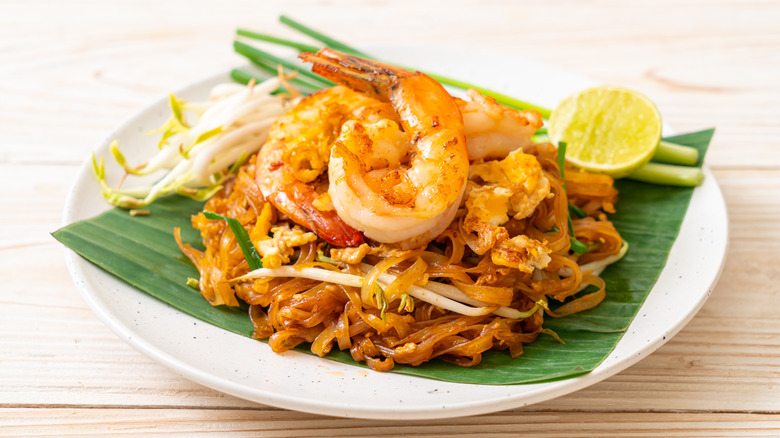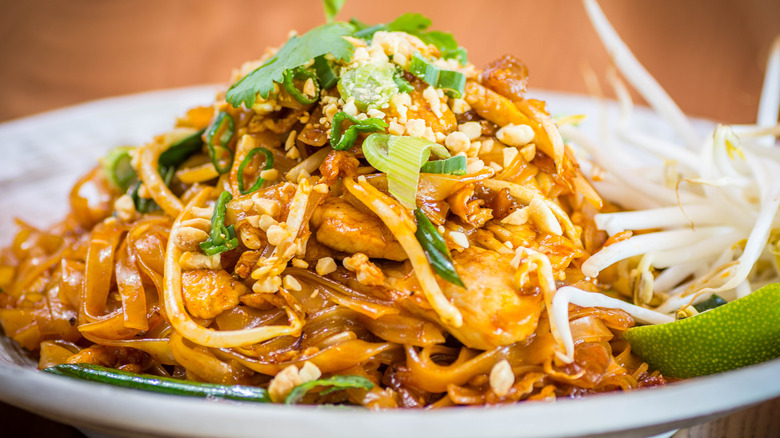The Unexpected Origins Of Pad Thai
The cuisine of Thailand holds a special place in the pantheon of the world's great food cultures. Signature dishes like pad thai and tom yum soup have expanded well beyond the southeastern nation's borders. You don't have to look hard to find good Thai food in major cities like Paris, Los Angeles, and Tokyo.
That's not by accident either. As The Splendid Table reports, during the early 2000s, the Thai government started training individuals how to open and run their own Thai restaurants abroad. Many Thai citizens then emigrated to new countries to set up shop and spread the gospel of Thailand's delicious cuisine.
This is a success story that's about more than just good training though. Thai food is also delicious. Thai food is well known for its complex blend of intricate but delicious flavors. Salty, savory, sweet, and the rest of the taste buds are all indulged with every bite of a proper Thai dish. This unique balance is best represented by one of Thailand's most famous foods — pad thai. Pad thai's reputation wasn't by accident either, and also results from government programming.
Promoting the new Thai identity
Thailand has a long and complicated history leading up to its recent modernization. According to Brittanica, for many centuries the country was known as Siam. However, a bloodless coup would occur in 1932 that would result in the overthrow of the ruling monarchs. This coup was mostly organized and executed thanks to Pridi Phanomyong and Luang Phibunsongkhram, who is also known as Plaek Pibulsonggram, or Phibun. Phibun would go on to become the country's military dictator in 1938 and change the name of the country to Thailand.
As The Atlantic reports, at this time, the world found itself falling faster toward what would become World War II. Seeing the cogs of war starting to turn, and knowing that his young country would be threatened, Phibun started to promote a new Thai nationalism and strove to modernize. Mental Floss adds that this even included forbidding some forms of traditional Thai dress, and promoting other Thai-made garments instead.
One of the most pressing issues of this period was a lack of sufficient food and nutrition for all of the Thai people (via The Atlantic). To combat the fear of famine in his country, Phibun would create a new, nationalist dish that would help ration supplies, all while providing adequate nutrition.
How pad thai was invented
As Phibun secured his power in Thailand, he thought that a strong national identity would help boost their prospects of continued independence, and felt a national dish would help with this (via Atlas Obscura). So, The Atlantic claims that he took his inspiration from home, and began promoting a dish that was commonly served there. The precise creator of the dish is unclear, but the fact that pad thai was centered around rice noodles — which helped conserve the supplies of the grain — and featured several forms of protein made it a nutritious, conservative, and flavorful choice.
Mental Floss says that the campaign slogan, "noodle is your lunch," was then introduced to help promote the dish. The Atlantic adds that the recipe was also spread among street vendors to promote it as well. The campaign worked, and pad thai quickly became a popular dish associated with the new Thailand.
Pad thai was an odd choice for a national dish though, as most of the ingredients came from other nations. At this time, stir-fried rice noodles would have still been regarded as a Chinese invention, and ingredients like mung beans, peanuts, and chili peppers all have origins in other countries. The new dish still captured the complex flavors enjoyed by the people of Thailand though, and nearly 100 years later has spread around the world.


